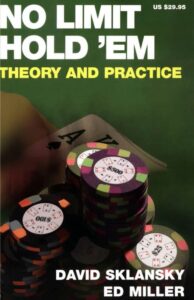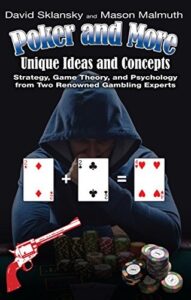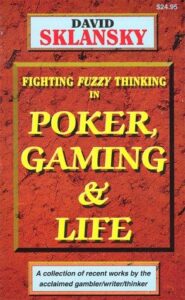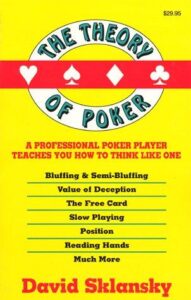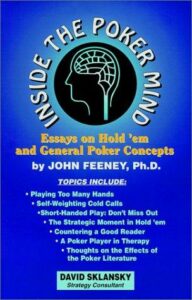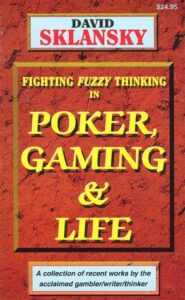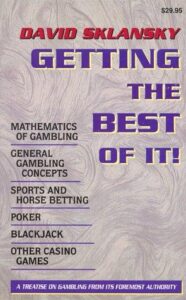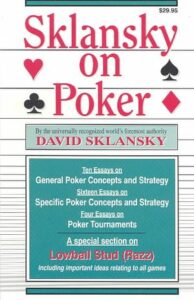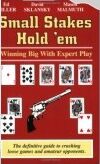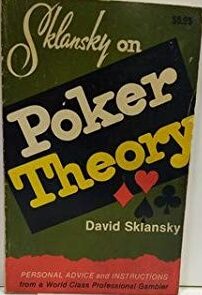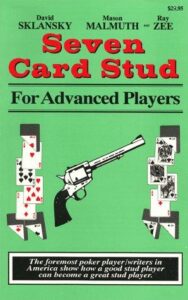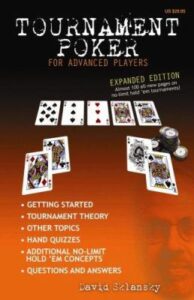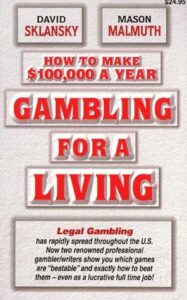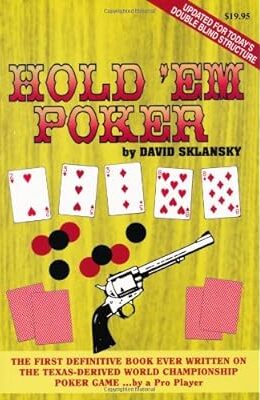Poker Books by David Sklansky
Showing all 17 results
No Limit Hold ’em
The book provides an in-depth exploration of no-limit hold’em strategy and aims to teach players how expert players think about the game. Mastering the key concepts can provide a significant edge over typical opponents.
Poker, Gaming, and Life
This book compiles articles by David Sklansky, previously published in Card Player, Poker World, and the Two Plus Two Poker Strategy Magazine, along with some never-before-seen pieces. The majority of the articles focus on poker and gambling, but Sklansky has also ventured into other subjects, analyzed in his distinctive style. The book includes essays on poker and gaming topics like being a favorite, talent versus discipline, and never go broke, as well as life topics like what It Is that makes an issue controversial and crime and punishment. The expanded edition features 32 new essays, many focusing on no-limit hold ’em.
The Theory of Poker
This book explores theories and concepts relevant to almost every version of poker, including five-card draw (high), seven-card stud, hold ’em, lowball draw, and razz (seven-card lowball stud). It presents the Fundamental Theorem of Poker, its implications, and its impact on your gameplay. Additional chapters cover the importance of deception, bluffing, raising, slow-play, position, psychology, heads-up play, game theory, implied odds, the free card, and semibluffing. Many leading poker players credit this book for significantly improving their game. Essentially, it distinguishes expert players from average ones. Those who read and study this book will outpace those who don’t, with most serious players frequently referencing their well-worn copies. It’s hailed as the finest book on poker ever written.
Inside the Poker Mind
Mastering all the skills of poker, including hand selection, playing position, image projection, and hand reading, is essential to becoming an expert. However, many players who have these skills still struggle, especially when playing against superior opponents. The key is not just having the skills, but effectively integrating them. This book will demonstrate that winning at poker requires strategic thinking and a systematic approach to the game.
The Theory of Poker Applied to No-Limit
David Sklansky’s The Theory of Poker is a seminal book in the poker world, originally written with limit games in mind. However, no-limit hold ’em has since become the most popular form of poker. As a result, Sklansky felt the need to write a new book, The Theory of Poker Applied to No-Limit, which revisits and expands on the original chapters, adapting them for no-limit and pot-limit games. The book also includes new bonus chapters and thoughts specifically for big bet games. It emphasizes no-limit hold ’em, but the concepts can be applied to other games like pot-limit Omaha and no-limit single draw deuce-to-seven lowball. The book doesn’t provide specific play instructions, but guides readers on decision-making based on opponent knowledge, poker math, and logic. While some sections may be complex, most of the book is accessible to intermediate players, with key points summarizing each chapter.
Fighting Fuzzy Thinking in Poker, Gaming and Life
This book compiles a selection of articles by David Sklansky, previously published in various outlets like Card Player, Poker World, and the Two Plus Two Poker Strategy Magazine, with a few making their first appearance in print. While most articles focus on poker or gambling, David has also explored other subjects, applying his distinctive analytical approach, and this collection includes some of those essays. Additionally, this volume features 32 extra essays, with a significant number discussing no-limit hold ’em. Among the essays for the Expanded Edition are titles like “Pros Versus Wannabes,” “Bluff Raising as the Big Blind,” “Evaluating Expected Value,” and “Expert Non-Optimum Random Strategy.”
Sklansky On Poker
In this comprehensive poker book, David Sklansky combines his previous works Sklansky on Razz and Essays on Poker” along with new material, to create a valuable resource for poker players. The book is divided into two main sections: essays and razz. In the essays section, Sklansky discusses crucial concepts such as developing a plan, selecting the right game, playing within your bankroll, the three levels of expert poker, middle-round strategy, understanding your opponent’s perception of you, the protected pot, saving the last bet, extra outs, and tournament play. The razz section provides an in-depth look at how experts approach this unique poker variant. Sklansky not only explains the rules and structure of razz but also offers advice on playing the first three cards and all subsequent streets. To reinforce the lessons, the book includes a chapter of razz problems and a series of questions and answers to keep your skills sharp. This combination of strategic essays and razz-specific instruction makes this book an essential addition to any poker player’s library.
Small Stakes Hold ’em
For today’s poker players, Texas hold ’em is the game, with tens of thousands of small stakes hold ’em games played daily around the world in homes, card rooms, and on the Internet. These games can be very profitable if you play well, but most people don’t and end up leaving their money on the table. this book explains everything you need to be a big winner, teaching the aggressive and attacking style used by all professional players. Unlike many other books about small stakes games, it doesn’t just tell you to play aggressively; it shows you exactly how to make expert decisions through numerous clear and detailed examples. The book covers topics such as implied odds, pot equity, speculative hands, position, the importance of being suited, hand categories, counting outs, evaluating the flop, large pots versus small pots, protecting your hand, betting for value on the river, and playing overcards. After learning the winning concepts, you can test your skills with over fifty hand quizzes that present common and critical hold ’em decisions, allowing you to choose your action and compare it to the authors’ play and reasoning.
Sklansky on Poker Theory
The essays section includes chapters that explore various concepts such as strategic planning, game selection, bankroll management, expert poker levels, mid-round tactics, opponent perception, protected pot, saving the final bet, extra outs, tournament play, and more. The razz section offers insights into how professionals play this poker variant. It not only outlines the game’s rules and structure but also provides guidance on playing the first three cards and subsequent streets. Additionally, it features a chapter on razz problems, complete with questions and answers to hone your skills.
Seven-Card Stud for Advanced Players
Seven-card stud is a highly intricate game, making it challenging to devise the perfect strategy for every situation. This complexity might explain why few have attempted to dissect it, despite its popularity. In 1989, the first edition of this book was published, revealing strategies previously known only to a select few, thus filling a significant void in poker literature. Now in the new century, the authors have further advanced the field by adding over 100 pages of fresh content, including a comprehensive section on “loose games.” With discipline, study of this text, and proper experience, one can become a significant winner. It also covers topics like cards that are out, number of players in the pot, ante stealing, playing pairs and three-flushes, randomizing play, and strategies for each street, among others.
Tournament Poker for Advanced Players
Tournament poker differs significantly from regular ring game poker. Despite seeming similar, the strategic nuances are often overlooked by seasoned cash game players. Some individuals excel in tournament poker due to their advanced grasp of strategic adjustments and their timely application. It’s not surprising that these players consistently reach final tables. This book uncovers tournament strategies mastered by only a few. It presumes you’re already a competent poker player but need to understand tournament-specific strategies and their application. Topics include: bankruptcy effects, the Gap Concept, chip value fluctuations, adjusting to increasing stakes, all-in strategy, final table tactics, deal-making, the “System,” targeting weaker opponents, unusual aces and kings plays, blind moves, and more. The updated edition adds over 100 pages, focusing mainly on today’s most popular tournament poker variant: no-limit hold ’em.
How to Make $100,000 a Year Gambling for a Living
David Sklansky and Mason Malmuth have dedicated many years to writing about the intricacies of poker, blackjack, and other games that can be beaten. This book is a guide for the aspiring gambler who is not yet highly experienced. It offers a comprehensive look at what you need to know and do to make a living from gambling, covering both practical and technical aspects. The authors explain that making a good living exclusively through gambling is challenging but achievable. They highlight the importance of understanding which games offer a realistic chance of winning and how to master them.
Among the games considered beatable and discussed in this book are poker, blackjack, horses, sports betting, progressive slots, video poker, casino tournaments, and special promotions. The authors make it clear why they do not include games like craps, roulette, keno, or baccarat, providing explanations within the book.
The text underscores that many thousands of people successfully earn their livelihood through gambling. David Sklansky and Mason Malmuth are just two examples of individuals who have not only succeeded in this field but have also taken the time to share their knowledge. As the book unfolds, readers will discover the essential strategies and insights needed to potentially gamble for a living. However, the authors remind us that the journey requires dedication and effort, as the rest is up to the individual.
Geeking, Grifting, and Gambling Through Las Vegas
A semi-autobiographical work that intertwines engaging stories, often involving well-known and sometimes unpleasant figures, with gambling insights and other advice. It presents a psychological self-portrait of a “math nerd” who, by confronting Las Vegas, overcame mild autism. This narrative is enriched by juicy anecdotes and a unique perspective, all by a writer who navigates through life’s challenges with a blend of mathematics and personal growth.
Hold’Em Poker for Advanced Players
The updated version of this book is called “Limit Hold ’em Poker for Advanced Players”
Hold’em Poker
This book is essential reading for anyone looking to get into hold ’em poker. Originally released in 1976, it stands as the first comprehensive guide on the subject. Despite its age, it remains a top seller among poker books, thanks in part to a significant update in 1997 that modernized it for the current double blind structure of the game. Aimed at newcomers, the book also offers advanced insights beneficial to all levels of players. It is perhaps most famous for introducing the Sklansky Hand Rankings, simplifying the game’s complexities. The guide covers a wide range of topics, including the basics of Texas hold ’em, the criticality of position, strategies for the first two cards, understanding key flops, pre-flop strategy, the art of semi-bluffing, leveraging the free card, the tactics of slowplaying, the strategy of check raising, navigating heads-up on fifth street, and techniques for hand reading.
Showing all 17 results
